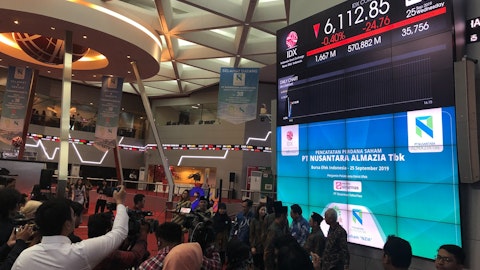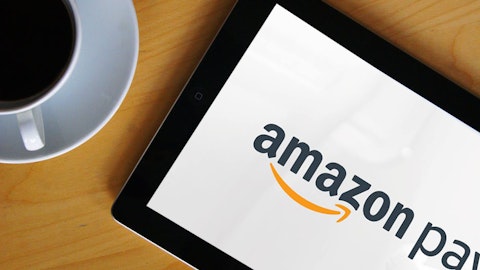Costco Wholesale Corporation (NASDAQ:COST) Q1 2024 Earnings Call Transcript December 14, 2023
Costco Wholesale Corporation beats earnings expectations. Reported EPS is $3.58, expectations were $3.42.
Operator: Good day, everyone, and welcome to the Costco Wholesale Corporation Fiscal First Quarter 2024 Earnings Call. Today’s call is being recorded and all lines have been placed on mute to prevent any background noise. After the speaker’s remarks, there will be a question-and-answer session. [Operator Instructions] I would now like to turn the call over to Richard Galanti, Chief Financial Officer. Please go ahead, sir.
Richard Galanti: Thank you, Lisa, and good afternoon to everyone. I will start by stating that these discussions will include forward-looking statements within the meaning of the Private Securities Litigation Reform Act of 1995. These statements involve risks and uncertainties that may cause actual events, results and/or performance to differ materially from those indicated by such statements. The risks and uncertainties include but are not limited to those outlined in today’s call, as well as other risks identified from time-to-time in the company’s public statements and reports filed with the SEC. Forward-looking statements speak only as of the date they are made, and the company does not undertake to update these statements, except as required by law.
Comparable sales and comparable sales excluding impacts from changes in gasoline prices and foreign exchange are intended as supplemental information and are not a substitute for net sales presented in accordance with GAAP. In today’s release, we reported operating results for the first quarter of fiscal ’24, the 12 weeks ended November 26. Reported net income for the 12-week first quarter came in at $1.589 billion or $3.58 per share, up from $1.364 billion or $3.07 per share in the 12-week first quarter last year. This year’s results included a tax benefit of $44 million or $0.10 a share related to stock-based compensation. Last year’s results included a tax benefit of $53 million or $0.12 per share related to stock-based compensation and also included a charge of $93 million pre-tax or $0.15 per share primarily related to downsizing our charter shipping activities.
Net sales for the first quarter were $56.72 billion, a 6.1% increase over last year’s first quarter, $53.44 billion. Net sales were benefited by approximately 0.5% (ph) to 1% in the U.S. and worldwide from the shift of the fiscal calendar as a result of the 53rd week in fiscal 2023. The following comparable sales reflect comparable locations year-over-year and comparable retail weeks. In the U.S. reported 2% comp sales ex-gas deflation and FX 2.6%. Canada reported 6.4%, ex-gas and FX 8.2%. Other International reported 11.2%, ex-gas and FX 7.1%. For total company reported 3.8% and at 3.9%, excluding those two items. E-commerce, which was reported as a 6.3% came in at 6.1% excluding FX. Overall, for the first fiscal quarter, fresh foods were relatively strong once again, with food and sundries right behind.
Non-food showed improvement over the September October, November time frame as did e-com sales. In terms of Q1 comp sales metrics, traffic or shopping frequency increased 4.7% worldwide and 3.6% in the United States. Our average transaction was down 0.9% worldwide and down 1.6% in the U.S. Foreign currencies relative to the U.S. dollar positively impacted sales by approximately 0.4%, while gasoline price deflation negatively impacted sales by approximately 0.6%. I’ve gotten more than a few calls in the past few weeks as to how many pies we sold in the U.S. leading up to the Thanksgiving holiday. In the U.S., in the three days leading up to Thanksgiving, we sold 2.9 million of our famous Pumpkin Pies along with 1.3 million apple and pecan pies, so over 4 million pies in total during the three days.
Back to the income statement here and next on the income statement’s membership fee income. In the quarter, we reported $1.082 billion or 1.91%, that’s an $82 million or 8.2% increase and a 4 basis point increase over the first quarter last year. In terms of renewal rates, at first quarter end, our U.S. and Canada renewal rate stood at 92.8%, while the worldwide rate came in at 90.5%. Both of these rates were up 0.1% from those numbers 12 weeks earlier at the end of the fourth quarter. Membership growth continues. We ended Q1 with 72.0 million paid household members, up 7.6% versus last year and 129.5 million cardholders, up 7.1%, with consistent growth throughout the quarters. At Q1 end, we had 33.2 million paid Executive members, an increase of 939,000 during the 12 weeks since Q4 end.
Executive members now represent a little over 46% of our paid members and a little over 73% of worldwide sales. Moving down the income statement next is, our gross margin. Our reported gross margin in the fourth quarter was higher year-over-year by 43 basis points, coming in at 11.04%, up from Q1 of last year at 10.61%. That 43 basis point reported number ex-gas deflation would be plus 36 basis points. As I normally do here, we write down two columns and six line items. The first column is reported in the first quarter. The second column is margins, excluding gas deflation. It’s the year-over-year change in the first quarter. On a core merchandise, plus 3 basis points reported, minus 3 basis points ex-deflation. Ancillary and other businesses, plus 24% reported and plus 22% ex-gas deflation; 2% reward lower year-over-year, minus 4 basis points reported and minus 3 ex-gas deflation; LIFO, plus 3 and plus 3 and other plus 17 and plus 17 for a total, again, reported year-over-year up 43 basis points and ex-gas deflation up 36 basis points.
Starting with the core. Again, it was total company, it was plus 3 and minus 3 reported and ex-gas deflation. In terms of core margin on their own sales, our core-on-core margins were up by 5 basis points year-over-year. Ancillary and other business gross margin, again, higher by 24 and higher by 22 ex-gas deflation. This increase was driven largely by gas and e-comm. Our 2% reward higher by 4 and higher by 3 ex-deflation, reflecting higher sales penetration coming from our Executive members. LIFO plus 3 basis points. We had a $15 million LIFO credit in the first quarter of this year. This compared to a very small $0.5 million LIFO charge in Q1 a year ago. And then, the other line item, the 17 basis points to the positive. As was mentioned earlier, last year in Q1, there was a 17 basis point impact from a $93 million pre-tax charge, primarily related — primarily for the downsizing of our charter shipping activities.

Moving on to SG&A. We reported SG&A of 9.45%, higher by 25 basis points than last year’s 9.20%. Again, in Q1, we’re right down the two columns. Reported and without gas deflation, operations, minus 18 and minus 14 basis points, minus being — meaning it’s higher year-over-year. Central minus 2 and minus 1. Stock compensation minus 3 and minus 2. Pre-opening expense, minus 2 and minus 2, again, for a total reported margin higher minus 25% year-over-year. I’m sorry, SG&A, not margin, 25 and without gas deflation, higher by 19 basis points. The quarter again was higher by 18 and higher by 14, excluding the impact from gas. This included 12 weeks of this past March’s extra top of scale increase in our wages, which represents an estimated 2 basis point hit.
And as of September 18, we raised the starting wage in the U.S. and Canada, that estimated impact from those new wages to be roughly 2 basis points as well. Again, central, nothing much to say other than its 1 basis point higher, excluding gas deflation. Again, it was stock comp’s, the minus 2x gas deflation and pre-opening. We did have a couple of more openings this year in the quarter than we did last year and that was higher by 2 basis points. Below the operating income line, interest expense was $38 million this year, $4 million higher than last year’s $34 million figure. Interest income and other for the quarter was higher by $107 million, coming in at $160 million this year versus $53 million last year. This was driven largely by the increase in interest income, about $100 million of that $107 million due to higher interest rates as well as high cash balances.
The small additional impact was a favorable FX year-over-year. In terms of income taxes, our tax rate in the first quarter was 24.5%. This compares to 23.0% a year ago or 1.5 percentage points higher this year than last year. The increase in our rate as of Q1 — in Q1 is primarily attributable to lower benefit from the stock-based compensation from a year ago. Overall, reported net income was up 16.5% year-over-year in the quarter. A few other items of note. In terms of warehouse expansion in the first quarter, we opened 10 locations, including one relo (ph), so a net of nine increases. That — those nine included eight in the U.S. and one in Canada. For the full year fiscal ’24, we estimate opening — we’re planning to open 33 locations, including two relos, so for a net increase of 31 new warehouses that would be up from 23 that we opened in fiscal ’23.
For Q2 fiscal ’24, we plan four new locations, including our sixth building in China, are early in the calendar year. Regarding capital expenditures, first quarter capital expenditure spend was approximately $1.04 billion. We estimate that fiscal ’24 CapEx will be in the $4.4 billion to $4.6 billion range, that’s up from $4.3 billion we had in fiscal ’23, reflecting a continued increase in the number of the expansion that we’re doing. In terms of e-commerce business, e-com sales in Q1 ex-FX increased 6.1%, the first quarterly year-over-year increase in five fiscal quarters and trended well during the three reporting periods of September, October, November. E-comm showed strength in several areas. In food, things like e-gift cards, pet items, snack items were up in the mid-teens.
Appliances were up year-over-year in the mid-20s. TVs was actually in the high-singles despite the challenges with other aspects of consumer electronics like computers, and tires were up in the low-teens. So overall, a pretty good showing there. As well, Costco Logistics enjoyed record-breaking deliveries. In the first quarter of fiscal ’24, we completed over 800,000 deliveries, which were up 17% versus the comparable quarter last year. And some fun wow items in the quarter in e-commerce. You’ve probably read about the fact that we’re selling gold 1 ounce gold bars. We sold over $100 million of gold during the quarter. We sold a Babe Ruth autographed index card for $20,000. And in addition to e-gift cards on everything from restaurants to golf to airlines, and we just in the last couple of weeks, launched a Disney e-gift card valued at $250 for $224.99.
And for you last-minute shoppers out there, there is a Mickey Mantle autographed 1951 Rookie Card in nearly perfect condition and it’s on sale online for $250,000. Next, good progress continues to be made with our e-com mobile and digital efforts. No big enhancements and changes to the site leading up to the holiday, mostly holiday prep. We did have 100% site availability during Cyber week, and sales for the five Cyber Days, Thanksgiving, Black Friday, Saturday, Sunday, and Cyber Monday were up year-over-year in the mid-teens. Our app downloads during the quarter were 2.75 million, so total app downloads are now stand at 30.5 million or a 10% increase during the quarter, and that’s after up being over 40% increase in all of fiscal ’23 versus the prior year.
Our site traffic approaching 0.5 billion and just under 10% increase and the average order value being up about 2.5%. So we continue to make progress there. Next couple of comments regarding inflation, most recently in the last fourth quarter discussion. We had estimated that year-over-year inflation was in the 1% to 2% range. Our estimate for the quarter just ended, that inflation was in the 0% to 1% range. Bigger deflation in some big and bulky items like furniture sets due to lower freight costs year-over-year as well as on things like domestics, bulky, lower priced items again, where the freight cost is significant. Some deflationary items were as much as 20% to 30% and again, mostly freight-related. TVs, the average sale prices have been lower while unit’s been higher.
And talking to the buyers overall, our inventories and our SKU counts are in good shape across all channels. And so far, we’ve had a good seasonal sell-through during the quarter. Lastly, as you saw in this afternoon’s press release, we declared a $15 per share special cash dividend. This is our fifth special dividend in 11 years. The total payout will be about just under $6.7 billion and will be funded using existing cash and not accompanied by any issuance of debt. The special cash dividend will be paid on January 12th to shareholders of record on December 28th. Finally, in terms of upcoming releases, we will announce our December sales results for the five weeks ending Sunday, December 31, on Thursday, January 4th, after market close. With that, I will turn it back for Q&A to Lisa and be happy to answer any questions.
Operator: Thank you. [Operator Instructions] We’ll take our first question from Michael Lasser with UBS.
See also 14 Best Automation Stocks To Buy Now and 9 Quantum Computing Stocks Billionaires Are Piling Into.
Q&A Session
Follow Costco Wholesale Corp W (NASDAQ:COST)
Follow Costco Wholesale Corp W (NASDAQ:COST)
Michael Lasser: Good evening. Thank you so much for taking my question. You had indicated over the last 1.5 years or so that Costco had been raising prices faster than it had throughout its history. So now with prices coming down, what is going to be the posture on passing along those savings? You already noted that inflation is flat to up 1%. So do you expect deflation, especially on the food side as you get through the next couple of quarters?
Richard Galanti: Well, talking to buyers, we’ve seen that even during the quarter, we saw a trend towards that 0% versus the 1%. But at the end of the day, we don’t — the buyers are looking out three to six months. They have — on the fresh food side, commodities-wise, they haven’t seen a lot. There are a few things that are up and a few things are down, but no giant trend either way. Look, as you know us for a long time, we want to be the first to lower prices. We’re out there pressing our vendors as we seek different commodity components come down and certainly on the non-food side, as we saw shipping costs come down, things like that. And so probably a little more than less, but we’ll have to wait and see. We don’t know.
Michael Lasser: And my follow-up is another point that you’ve made for a long time is that Costco’s going to draft off the profitability of the broader retail sector. If you compare Costco’s operating margin over the last 12 months versus where it was prior to the pandemic, it’s 300 to 400 basis points higher. And yet, across retail, there are signs that profitability is coming down. So now, what we’ve seen in the ways of Costco either maintaining this existing rate of operating profit margin or even further growing it from here, so it just simply going to be a function of your ability to drive further sales growth in the — consistently mid-single digit range or better.
Richard Galanti: Sure. Well, happily, I’m able to say that, that’s — you get to figure that one out. At the end of the day, we’re — as you’ve known for a long time, we’re a top line company, we want to drive sales. Certainly, as there’s been deflation in certain products, we’ve seen units go up. I’m looking at one example here just in the last month, $100 million plus of KS net items where sales were flat to down a couple percent, while units were up in the mid-teens, that takes a little more labor to do. But at the end of the day, that’s what we want to do. We want to drive people and frequency. I think as long as we see renewal rates continue to do what they do, as long as we see new sign-ups continue to what they do and hopefully continue to get people to convert to Executive as well and constantly driving the best value out there, we’ll be in good stead. And so far, we’ve been able to do that and I think we’ll continue to be able to do that.
Michael Lasser: Thank you very much and have a good holiday.
Richard Galanti: You too.
Operator: We’ll take our next question from Simeon Gutman with Morgan Stanley.
Jacquelyn Sussman: Hi, there. This is Jackie Sussman on for Simeon. Thank you so much for taking our question. The core and core margin was up modestly this quarter and it seems like it moderated sequentially. Looking forward to the balance of the year, it seems like the comparison gets a bit tougher. I guess how should we think about your core and core margin? Could it stay expanding and positive for the rest of the year or any color on that would be helpful. Thank you so much.
Richard Galanti: There are so many different moving parts to it. As you’ve heard me say and I say in the last several years, we want to drive top line first. We’re also pragmatic. We want — we recognize we’re a for-profit company and we’ll continue to work hard to do both. I wouldn’t read much into any number going up a little or down a little, frankly. It fluctuates and there’s lots of different components to it.
Jacquelyn Sussman: Got you. Thanks so much. And just a quick follow-up. Was the Black Friday and Cyber Monday gains that you had better than what you were expecting internally? Thanks so much.
Richard Galanti: They’re a little better than we were expecting but we were ready for it.
Jacquelyn Sussman: Thanks so much.
Operator: We’ll take our next question from Chuck Grom with Gordon Haskett.
Charles Grom: Hey. How is it going Richard? Good afternoon. I wanted to just dive into the core margins a little bit more and see if you could flesh out some of the category color. If you said it, I missed it, but food, sundries, fresh and on the hardlines parts of the business.
Richard Galanti: Well, without giving you specific basis points, food and sundries was slightly down, very slightly down. Non-food was actually up. Some of that relates to the fact that we are comparing against last year when we had higher freight costs and trying to drive business and fresh was down a little bit. So nothing Earth-shattering in either of those directions.
Charles Grom: Okay. And then on the ancillary up 22 basis points, I think we all get the gas component. But can you just talk about why the e-commerce margins were so much better in the quarter?
Richard Galanti: I think, well, first of all, part of just ancillary in general is a sales penetration issue. Without going into it that the fact that it showed more — sometimes when you look back over the quarters, they go in opposite directions, the core on core and then the other businesses. And so given that you had higher sales penetration in both and e-com, that helped you, and e-com, we had a lot of strength. We’re doing a lot of big and bulky and we’re driving that business.
Charles Grom: Okay. Great. And then just bigger picture, I just have a question on the change at the CEO seat with Ron starting in a few weeks and replacing Craig, who replaced Jim. You’ve had the fortunate opportunity to work with all three. And I guess I’m curious what change, if any, you think we could see from an operating standpoint moving forward?
Richard Galanti: Yeah. Well, I always joke I’m up for review so I’m going to say nice things. But at the end of the day, the reality is, we’re staying the course. I remember questions were asked 12-plus years ago when Craig became President, and two years later, Jim retired and Craig became CEO and President. And what’s — who can replace Jim? And I think the same questions asked today, who could replace Greg? And it really is a seamless transition. You have somebody retiring that’s been here 40-ish years and it’s been in the business both on operations and merchandising for a successful number of years in both. And you’ve got Ron who’s coming in, who started when he was 17 at a Price Club in Arizona. And he already has his 40-year gold patch.





